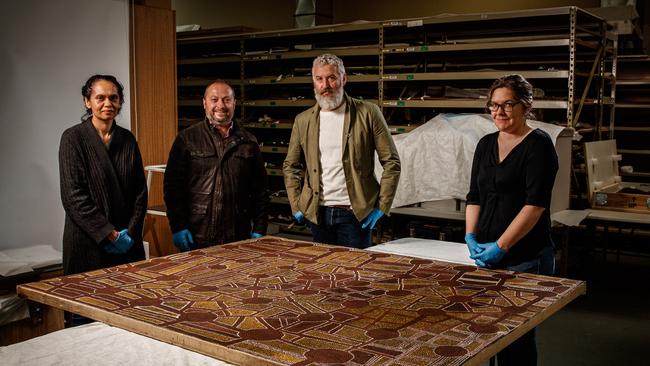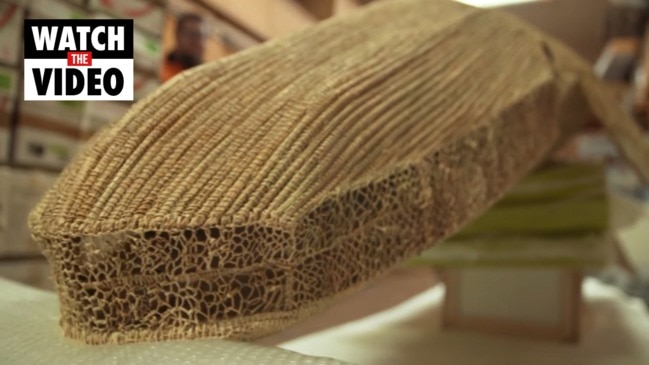The greatest stories never told – Inside the Netley warehouse that is home to the world’s largest collection of Indigenous artefacts
It’s the world’s largest collection of Aboriginal songlines in a nondescript warehouse at risk of damage by floods and vermin. SAWeekend takes a peek inside.

SA Weekend
Don't miss out on the headlines from SA Weekend. Followed categories will be added to My News.
There are songlines in the Adelaide suburbs. Well, there are songlines across the vast expanse of Australia, but some of those nearly 30,000 stories are being held in a shed at Netley.
The world’s biggest collection of Aboriginal stories sit in the western suburbs warehouse. The South Australian Museum is holding the products of 65,000 years of history in a vast, crowded space that used to hold the State Government’s printing presses.
The museum’s collection on display on North Terrace in the city is already one of the world’s most important, but it’s a tiny fraction of the whole. More than 95 per cent of its Aboriginal and Torres Strait Islander collection is at Netley.
There are stacks of boomerangs, woomeras, paintings and medicines up to 3m high, and all the paraphernalia of living history. And there are storylines, interrupted. Objects taken, stolen, and given.
On a bench, a series of toas is being unwrapped when SAWeekend pays a visit. The toas of Lake Eyre are sculptures that acted as signposts, and message boards.
People don’t know this is all here, not even many Aboriginal people. Those who do know need to make an appointment to see their cultural heritage. One of the big questions facing the museum is how to not just maintain, but improve that access.
Jared Thomas, a Nukunu man, is the William and Margaret Geary curator, Aboriginal and Torres Strait Islander Art and Material Culture at the SA Museum. (The position is funded by Margaret, in honour of her late husband William).
“How much of a disservice is it to Aboriginal people to have to come and see this in an industrial area that’s leaking?” he asks.
“We’ll bring Aboriginal elders into this space for the first time, and they’re blown away because they’re holding objects made by people who are sometimes as close as their grandparents. And then they’re able to communicate to us knowledge about those objects. They see a label, and it’s their grandmother’s name.

“It’s such a shame that so many Aboriginal people don’t know about this place. Only a fraction of Aboriginal people has ever stepped into this facility.”
Professor John Carty, the SA Museum’s head of humanities, works closely with Thomas. He describes the collection as the “greatest story we’ve never told”.
For now it’s being labelled, catalogued and microchipped. It’s being protected and curated, and being prepared to be moved ... somewhere. Some of it will become part of the new Aboriginal Art and Cultures Centre at Lot Fourteen, the details of which are still being worked through. Some of it will be put in storage somewhere safer.
Songlines conjure the idea of a mystical, mythical landscape – something nebulous. “They are anything but,” Carty says. “Songlines are perhaps best understood as creation stories, but while they trace ancient Dreamings, they are also a concrete way in which the oldest continuous civilisation on Earth mapped the continent. These songs are the Aboriginal archives of ecological, historical, religious and cultural knowledge. Within their eternal structures they also map dynamic cultural and environmental changes. Songlines map the memory of cultures, and also their futures.”
Aboriginal and Torres Strait Islanders understand the land by singing its stories – stories which also tell them how to find water, fertile land and previous hunting spots. At Netley, there is also a room for secret sacred objects, and a space for the repatriated remains of Aboriginal people.
Then there is the jewellery. Some of those who care for the collection showed SAWeekend a perfect, pink and pearly necklace which consists of dozens of luminous shells threaded into a piece of art. Another dramatic piece is made of echidna quills, pale then dark on the ends.
One of the precious items in the collection is a shield from Baroota, which is on Nukunu land in the Southern Flinders Ranges. It has a zigzag pattern made with rock or glass. “Baroota is where my great-great-grandmother lived with my great-grandfather,” Thomas says. “It was the first Aboriginal reserve in SA, and it’s at the centre of Nukunu post-colonisation identity.
“There are fewer than 20 Nukunu objects in the collection. This shield features patterning which speaks to the religious life of Nukunu people.”

Carty, looking over an enormous dot painting, talks about the need for people to understand, recognise, and respect the fact that there is an entire system of Aboriginal knowledge, and religion, and engineering – a whole world view that was suddenly interrupted by the arrival of the colonial fleets.
He says the new centre needs to be about truth telling, marking the atrocities that were done to the Aboriginal people, but it also needs to remind people that there were 65,000 years of a civilisation before that, and that it still exists.
“The power of this collection is that it makes visible those things that are invisible to the average Australian,” he says. “And the songlines, the most archetypally invisible thing on the planet, also form the biggest human structure on the planet.
“You might see (this painting) on a gallery wall and think, ‘That’s a pretty picture’ … but that’s the least you can learn. This is about revealing the underground waters that have animated the desert for people for thousands of years.
“This is a map that, when you have it in your mind, you know the names of the places and where you have to walk to … you know where the water is. It’s a system of knowledge that made this country into a home.”
It’s confronting to imagine how all these chapters in Australia’s history have been sequestered in this place. They were all at severe risk of damage from flooding, rats and burrowing bugs.
Thanks to some upgrades, the risk has lessened. But those watching over the collection still worry about the 25,000 artefacts, the hundreds of musical instruments and more than 1000 paintings. Then there are the sculptures, the textiles, a million photos and two million archaeological finds.
Alice Beale, the senior collections manager, humanities and world cultures, talks about her anxiety at the poor conditions in which this collection – the biggest of its kind in the world – is being housed.
“I was the one that came down and responded to the flooding,” she says of the time when there was little protection from big rains. Thousands of items were at risk of damage in 2016 by floods and vermin, and they’re not all safe yet.
“We either get a phone call or I tend to monitor the rain. I will come down at any given hour. Even the smallest leak could cause problems.”
She worries about bugs such as carpet beetles, which like protein – they get into feathers and hair. And there are actual food sources that attract other bugs. She worries about wood borers, mice and rats. Damage from the crowded stacks of boomerangs that can get knocked against each other.

“Even excessive light can cause problems,” she says.
Premier Steven Marshall says he was “appalled” when he first saw the conditions.
“I could see very clearly that we had something that was very precious,” he says. “We had thousands of years of artefacts, but more than that, we had thousands of years of stories and songlines in a completely and utterly inadequate facility at Netley.”
Marshall says the State Government put $2.6 million in for urgent works at the site, but still needs to figure out a longer-term solution. There is no doubt that the new centre at Lot Fourteen will be part of it.
Building is expected to begin in 2022 and the centre will receive $85 million from the Federal Government and $65 million from the State Government.
The Premier says it should have an Aboriginal name, something the First Nations people agree it should be called. It will be bigger than the SA Museum and the Art Gallery of SA added together, and host the largest collection of its kind in the world.
It will, he says, of course be “a place for truth telling”, but also a celebration of Aboriginal culture.
“We can’t paper over an uncomfortable truth,” he says. “We need to have all Aboriginal stories told and this space will be a place to do it using many different methodologies. Artefacts, paintings, weaving, dance, digital representations.”
There are many complexities to be navigated before the new centre goes ahead. Being in Adelaide, it will be on Kaurna land. But the collection contains things are from many of the hundreds of individual Aboriginal nations of Australia. Jeffrey Newchurch, a Narungga Kaurna elder, says all those nations must come together to work out what they want, and to then be fully engaged with the decision-making process.
“Aboriginal people need to be and must be included,” he says. “What does (the centre) look like for Aboriginal people; what’s the investment for Aboriginal people around that cultural precinct?
There have been reports of a “race” to establish a national centre of Aboriginal art and culture, as Perth and Darwin work on their own centres. But the Premier has made it clear that he won’t rush the process.
While there will be big and small details to work through, Thomas keeps coming back to the stories that need to be told. What the colonising forces had to do, from 1788 onwards, was to dehumanise the existing inhabitants of Australia. How else could they justify taking Aboriginal land and Aboriginal children?
Thomas says part of the role of revealing the collection is “re-humanising” Aboriginal people. Making his people visible. Helping people learn from the stunning jewellery, the complex art, the religious and the everyday items.
“Racism has existed for all of my life,” he says. “Like most Aboriginal people, my relatives were institutionalised.
“There are deliberate barriers to people’s progression in Australian society.
“So I am excited about telling our story in order to address racism, to show the sophistication of Aboriginal Australia, and its continuity. We’re still here.”
SONGLINES OF SA
■ The Seven Sisters is one of the most often significant creation tracks, the story of a journey from Western Australia (Martu country) to the Anangu Pitjantjatjara Yankunytjatjara (APY) Lands in South Australia, and beyond.
■ There are many versions and interpretations of the story, but the basic version tells of the Seven Sisters (Ancestral Women) being chased from Martu country by a lustful, evil spirit called Yurlu, who eventually drives the sisters into the night sky, where they become the Pleiades constellation.
■ As they flee from but also tease Yurlu, the sisters create a range of songlines. They create waterholes as they go, and boulders, and trek through hills. Their journey contains stories about family, hunting for food, about courtship and power, and the details of a chase across the country.
Source: National Museum of Australia

